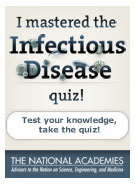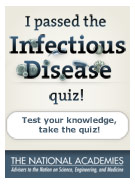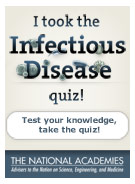
What You Need To Know About Infectious Disease
What do you know about infectious disease?
Which of the following is an effective way to protect yourself against infectious disease?
- Keep immunizations up to date
- Wash your hands often
- Prepare and handle food carefully
- All of the above
-
Sorry, that’s incorrect.
All of the above can help prevent infectious disease. Other behaviors, such as exercising caution around wild and unfamiliar domestic animals, avoiding insect bites, practicing safe sex, and being vigilant about disease threats while traveling abroad, can also reduce the risk of infection.
-
Sorry, that’s incorrect.
All of the above can help prevent infectious disease. Other behaviors, such as exercising caution around wild and unfamiliar domestic animals, avoiding insect bites, practicing safe sex, and being vigilant about disease threats while traveling abroad, can also reduce the risk of infection.
-
Sorry, that’s incorrect.
All of the above can help prevent infectious disease. Other behaviors, such as exercising caution around wild and unfamiliar domestic animals, avoiding insect bites, practicing safe sex, and being vigilant about disease threats while traveling abroad, can also reduce the risk of infection.
-
Correct!
All of the above can help prevent infectious disease. Other behaviors, such as exercising caution around wild and unfamiliar domestic animals, avoiding insect bites, practicing safe sex, and being vigilant about disease threats while traveling abroad, can also reduce the risk of infection.
Which of the following diseases kills more children worldwide than any other infectious disease?
- Lower respiratory tract infections (including pneumonia)
- HIV/AIDS
- Diarrheal diseases
- Tuberculosis
- Malaria
-
Correct!
Lower respiratory tract infections (including pneumonia) kill more children worldwide than any other infectious disease. Together these diseases are the five leading causes of infectious disease worldwide, accounting for nearly one-fifth of all deaths.
-
Sorry, that’s incorrect.
Lower respiratory tract infections (including pneumonia) kill more children worldwide than any other infectious disease. Together these diseases are the five leading causes of infectious disease worldwide, accounting for nearly one-fifth of all deaths.
-
Sorry, that’s incorrect.
Lower respiratory tract infections (including pneumonia) kill more children worldwide than any other infectious disease. Together these diseases are the five leading causes of infectious disease worldwide, accounting for nearly one-fifth of all deaths.
-
Sorry, that’s incorrect.
Lower respiratory tract infections (including pneumonia) kill more children worldwide than any other infectious disease. Together these diseases are the five leading causes of infectious disease worldwide, accounting for nearly one-fifth of all deaths.
-
Sorry, that’s incorrect.
Lower respiratory tract infections (including pneumonia) kill more children worldwide than any other infectious disease. Together these diseases are the five leading causes of infectious disease worldwide, accounting for nearly one-fifth of all deaths.
About how many airline passengers cross international borders daily?
-
Sorry, that’s incorrect.
An estimated 1.8 million airline passengers cross international borders daily, creating routes by which human infections can radiate around the world within hours.
-
Sorry, that’s incorrect.
An estimated 1.8 million airline passengers cross international borders daily, creating routes by which human infections can radiate around the world within hours.
-
Correct!
An estimated 1.8 million airline passengers cross international borders daily, creating routes by which human infections can radiate around the world within hours.
True or False: Antibiotics work by introducing an agent that resembles a disease-causing microbe, thus stimulating the body's immune system to recognize it as foreign, destroy it, and "remember" it, so that it can more easily identify and destroy any similar, disease-causing microbes that it later encounters.
-
Sorry, that’s incorrect.
The above describes how vaccines work. Antibiotics work by either killing bacteria or stopping them from reproducing, allowing the body's natural defenses to eliminate the pathogens.
-
Correct!
The above describes how vaccines work. Antibiotics work by either killing bacteria or stopping them from reproducing, allowing the body's natural defenses to eliminate the pathogens.
True or False: Not all microbes are harmful to humans.
-
Correct!
Not all microbes are harmful to humans. In fact, many of them protect us, helping our bodies function properly and competing with harmful organisms in an eternal contest for habitable space in or on our bodies. Although the microorganisms that cause disease often receive more attention, most microorganisms do not cause illness.
-
Sorry, that’s incorrect.
Not all microbes are harmful to humans. In fact, many of them protect us, helping our bodies function properly and competing with harmful organisms in an eternal contest for habitable space in or on our bodies. Although the microorganisms that cause disease often receive more attention, most microorganisms do not cause illness.
Which deadly pathogen cannot be found naturally in the wild:
-
Sorry, that’s incorrect.
Smallpox cannot be found naturally in the wild. Smallpox was officially declared eradicated from the globe in 1980, after an 11-year WHO vaccination campaign—the first human disease to be eliminated as a naturally spread contagion. Today, the virus remains only in laboratory stockpiles.
-
Sorry, that’s incorrect.
Smallpox cannot be found naturally in the wild. Smallpox was officially declared eradicated from the globe in 1980, after an 11-year WHO vaccination campaign—the first human disease to be eliminated as a naturally spread contagion. Today, the virus remains only in laboratory stockpiles.
-
Correct!
Smallpox cannot be found naturally in the wild. Smallpox was officially declared eradicated from the globe in 1980, after an 11-year WHO vaccination campaign—the first human disease to be eliminated as a naturally spread contagion. Today, the virus remains only in laboratory stockpiles.
How many people in the United States die from flu-related complications each year?
-
Sorry, that’s incorrect.
About 36,000 people die from flu-related complications each year in the United States. More than 200,000 are hospitalized.
-
Correct!
About 36,000 people die from flu-related complications each year in the United States. More than 200,000 are hospitalized.
-
Sorry, that’s incorrect.
About 36,000 people die from flu-related complications each year in the United States. More than 200,000 are hospitalized.
Roughly how many microbes live in the human gastrointestinal tract?
-
Sorry, that’s incorrect.
About ten trillion microbes live in the human gastrointestinal tract. They are essential for proper digestion and absorption of nutrients.
-
Sorry, that’s incorrect.
About ten trillion microbes live in the human gastrointestinal tract. They are essential for proper digestion and absorption of nutrients.
-
Sorry, that’s incorrect.
About ten trillion microbes live in the human gastrointestinal tract. They are essential for proper digestion and absorption of nutrients.
-
Correct!
About ten trillion microbes live in the human gastrointestinal tract. They are essential for proper digestion and absorption of nutrients.
In 2008, about how many people worldwide were infected with HIV (human immunodeficiency virus)?
-
Sorry, that’s incorrect.
In 2008, more than 33 million people worldwide were infected with HIV (human immunodeficiency virus). In that same year, an estimated 2 million people died from AIDS (acquired immunodeficiency syndrome), the final stage of HIV infection.
-
Sorry, that’s incorrect.
In 2008, more than 33 million people worldwide were infected with HIV (human immunodeficiency virus). In that same year, an estimated 2 million people died from AIDS (acquired immunodeficiency syndrome), the final stage of HIV infection.
-
Correct!
In 2008, more than 33 million people worldwide were infected with HIV (human immunodeficiency virus). In that same year, an estimated 2 million people died from AIDS (acquired immunodeficiency syndrome), the final stage of HIV infection.
Which of the following is not a viral disease:
-
Sorry, that’s incorrect.
Trichinosis is not a viral disease. It is caused by a helminth (parasitic worm) found in undercooked meat, not by a virus.
-
Sorry, that’s incorrect.
Trichinosis is not a viral disease. It is caused by a helminth (parasitic worm) found in undercooked meat, not by a virus.
-
Correct!
Trichinosis is not a viral disease. It is caused by a helminth (parasitic worm) found in undercooked meat, not by a virus.
Thank you for taking our quiz.
Place this badge on your Facebook page to show your friends what you know about infectious disease.
Place this badge on your Facebook page to show your friends what you know about infectious disease.
OR, get a higher score to unlock a different badge.
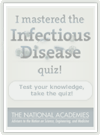
Place this badge on your Facebook page to show your friends what you know about infectious disease.
OR, get a higher score to unlock a different badge.
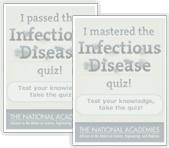
Explore Other Topics
Disease Watchlist
Infectious Disease Defined
- Encephalitis
Inflammation of the brain, often caused by a virus.
